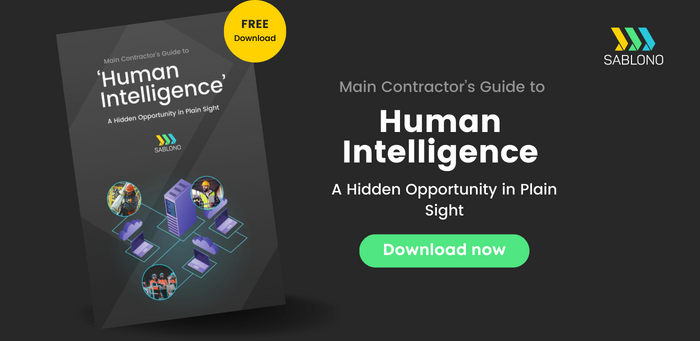Digital construction. A popular buzzword in construction, but what does it actually mean in today's world? In this article, we will explain everything you need to know about digital construction - its advantages, its challenges, and what exactly it means for you…
What is digital construction?
Digital construction is using digital technology to improve how a construction project is operated on, managed and delivered. In other words, this involves using digital tools across the management, delivery and operation of construction projects to bring about more collaborative and efficient ways of working.
How is digital construction changing the construction industry?
Safety
Tragedies like the Grenfell Tower have caused the whole industry to think more carefully about safety in construction. This combined with the rate of accidents that occur regularly on construction sites in the UK has created a place for digital construction.
This technology works to bring greater transparency and accountability on-site to help promote safer practices across the entire construction workflow.
Productivity
Productivity in construction is lagging behind the total economy. In a survey, 70% of contractors agreed that utilising advanced technologies helped them enhance productivity, while a study by McKinsey revealed that adopting digital technology was one of the key drivers that would help construction significantly improve their overall productivity.
By improving the efficiency of on-site workflows digital technology is helping to bring the construction industry to speed.
Profits
One of the underrated benefits of digital construction is that it helps to reduce costs on projects by capturing inefficiencies and streamlining processes. In fact, it’s estimated that digital technology can help reduce project costs by up to 45% - something that’s increasingly important in an industry where low margins have become the norm.
Construction 4.0
Construction 4.0 is the engineering and construction industry's version of Industry 4.0. It is a move towards greater digitisation of the construction industry. Technologies like 3D printing, artificial intelligence or AI and machine language will soon see a new era of construction. Simply put, the use of digital technology in construction is set to become the new standard.
Types of Digital Construction
1. Project management software
Project management software, otherwise known as progress monitoring software or on-site execution software is concerned with helping digitally manage the hundreds of thousands of activities that take place on a construction site. It helps to streamline construction execution - the construction phase that is notoriously difficult to manage and often results in costly mistakes and delays.
Project management software can be used by both project managers and trades working on a project. Parties can connect through their mobile devices, send real-time updates from anywhere and track every detail of the project.
This type of technology has seen a dramatic increase in investment activity due to its track record of having a significant impact on projects in both the short and long term.
Note: Sablono’s project management software can help make your project more efficient and profitable. You can schedule a personalised demo here.
2. BIM or Building Information Monitoring
BIM has taken the construction industry by storm and still remains one of the most talked about types of digital construction. It replaces traditional blueprints with 3D representations of buildings, using predictions and historical data to plan projects more efficiently. It can also be circulated to help visualise the project's progress.
3. Virtual and augmented reality
On a construction project, anything and everything can go wrong. This is why strategic and in-depth planning of the project is so crucial. This is where virtual and augmented reality shines.
Virtual reality or VR creates 3D simulations of buildings and augmented reality integrates digital information with the user's real environment in real-time. While VR works to help train workers on best-practice techniques to prevent errors, augmented reality or AR is useful to look forward to prevent hazards.
4. Robots and drones
With labour shortages, a major challenge for construction, drones and robots are helping to provide a solution by reinforcing the construction workforce. They can be used in everything from site walk-throughs, safety inspections, site logistics and monitoring the progress of the project. While robots and drones won’t replace people just yet, it is expected that they will increasingly be used in construction to provide a helping hand.
5. Machine learning and artificial intelligence
Machine learning and AI on the construction site work by using data to understand patterns to predict what will happen in the future. This can be a game changer when it comes to understanding the root cause of delays, reducing costs and mitigating risks.
Examples of digital construction
So how does digital construction work in practice? Below are just a few real-life examples which illustrate how technology can be used on construction projects.
Façade panels
Digital construction processes are used both for onsite construction processes and the monitoring of offsite production management. One of the best examples of this is the production of façade panels for Schneider Fassaden, Europe's leader in rear-ventilated façade construction.
They employed digital technology to create a built-in QRcode system for tracking the individual components from production to the final installation site. This gave them insights into the status achieved in the production, delivery and assembly process. It also helped them to ensure that all information was digitally documented and delivered to the desired quality which helped them to overcome uncertainties regarding the whereabouts of individual plates.
Residential apartments
Managing large-scale residential developments requires meticulous planning. The Mill Harbour Residential Development in London features staggering 937 residential apartments, two schools, and 63,000 sq feet of commercial space.
They were able to employ digital technology to monitor and analyse the execution of the complete project delivery including substructure, superstructure, envelope production and installation as well as the fit-out of the units. Detailed project controls and seamless digital task management across all companies and parties helped them to gain a holistic, real-time view of their project while creating the crucial golden thread of information.
Note: Discover the digital technology that was used in the above examples. Sablono transforms projects effortlessly.
10 Advantages of Digital Construction
- Enhanced safety & compliance
- Improved risk mitigation
- Better transparency & accountability
- Increased productivity
- Greater accuracy
- Better collaboration
- Faster decision-making
- Better data management
- Better quality projects
- Improved cost management
3 Challenges of Digital Construction
1. Time-consuming baseline capturing
To get started with digital construction and determine the true value it provides on your projects, it’s important to first identify where exactly you are. Capturing baseline data to determine metrics like the average time spent on current everyday tasks is a time commitment that not everyone is willing to invest in. Skipping this step will ultimately lead to putting forward a weak case for digital technology, which is more likely to be passed over by stakeholders.
2. Subcontractor resistance
Introducing digital tools and software is more complicated than simply digitising construction processes. Projects are mostly multi-person, multi-tier, and multi-organisation in nature. Subcontractors are often faced with having to use multiple different technologies across projects which can make them hesitant to adopt additional tools and this can lead to technology deployment failures.
3. Broken processes
Digital tools alone don’t fix broken construction processes. Many of the practices and ways of working used on the jobsite are flawed and need to be fixed before digital construction can be effective.
Note: Adopting a platform like Sablono works to resolve the broken processes on the jobsite while digitalising the entire construction execution phase. Learn more here.
Digital construction and the Building Safety Act
Dame Judith Hackitt outlined a building safety act in her independent review on fire and building regulations known as "The Golden Thread" after the Grenfell tragedy of 2017. The report recommended a more collaborative approach toward sharing information regarding high-rise residential buildings or HRRB.
Other sections of the report also mandated the use of BIM or Building Information Modelling. Moreover, the following recommendation related to digital technology in construction was laid down in the golden thread:
“There should be a government-mandated digital method of storing information regarding records and building construction. It should also include additional details on refurbishments.”
Phases of digital technology construction
Digitisation
Digitisation is the process of moving from paper-based systems to digital, a process also known as digital enablement. Digitisation increases the availability of information so that it can be accessed from anywhere and at any time.
Digitalisation
Digitalisation is when data and processes are moved from paper-based systems to digital ones. Digitising processes as well as data helps to drive efficiency gains across an organisation.
Digital transformation
Digital transformation is when all elements of an organisation are enhanced through digital technology. This includes everything from strategies, employee enablement, jobsite workflows and applications. Digital transformation may encompass many digitalisation initiatives and it ultimately looks at harnessing digital tools to bring about business transformation.
Getting started in your digital construction journey
1. Focus on fixing pain points rather than installing IT solutions
Construction companies around the world are investing in software to enhance field productivity. However, in many cases, this technology is being installed prematurely before companies understand how these tools will work in practice to solve their business challenges.
Instead, you should first identify operations you’d like to improve and define digital use cases to bring these operational changes to pass. The key is to employ technology to fix pain points rather than simply jump a trend.
2. Implementing digital use cases to promote collaboration
One obvious benefit of digital construction to the construction industry is the fact that it can help break down silos and foster collaboration on-site and beyond. Before implementing technology, you should think about how the technology can be used across different parties. How will the digital be used by those on-site and how will this information be fed back to those at head office?
Thinking about these things in advance will ensure that the digital technology you employ will have a lasting impact.
3. Share your vision
You’ve probably gathered by now that successfully deploying technology takes more than a great tool or device. People in your business will be the make or break of its deployment. You must understand the benefits of the technology for both those on-site and in the boardroom and communicate these unique benefits to each party. In the long term, cultural change is key to success, so don’t underestimate the power of spreading your vision.
4. Create a strategy
Clearly defining where you want to go as a company and taking a bottom-up approach to understand the exact steps you’ll need to take to get there is essential. This will help you understand the type of technology that will work best for projects and will also help you to determine the type of technology provider you’ll need to reach your goals. You should work with decision-makers to ensure that all stakeholders are on the same page.
Get your free copy
Margins are one of the biggest concerns in the industry at the moment and that’s why we created ‘The Definitive Guide to Securing Margins with On-site Digital Construction’.
You’ll discover how the power of digital construction can help make your projects more profitable. Others have saved over £10,000 per month on projects by simply implementing the steps we share in this e-book and you can too.



